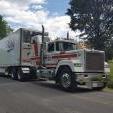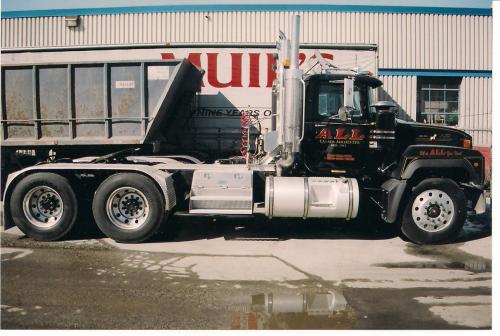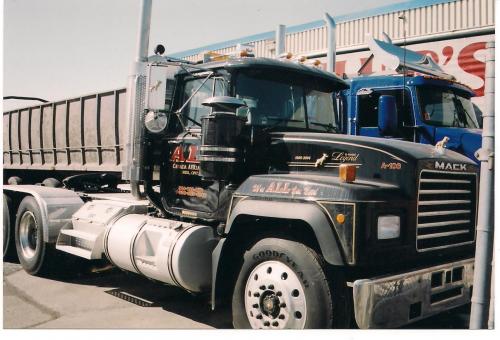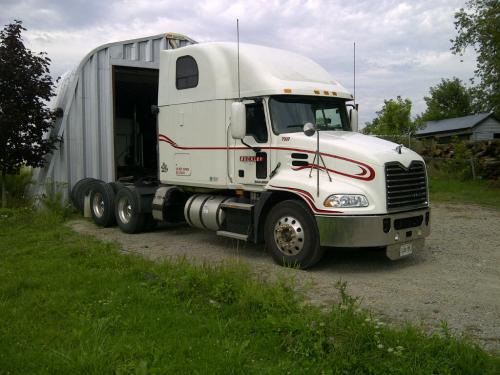-
Posts
1,089 -
Joined
-
Last visited
-
Days Won
3
Content Type
Profiles
Forums
Gallery
Events
Blogs
BMT Wiki
Collections
Store
Posts posted by bbigrig
-
-
No our 93 "MH"'s were E7-300's but I don't see where that would make a difference?
We had 2 '85 "MH"'s with EM6-300's and 2 '87 "MH"'s with E6-300's and they all had the boxes on them like yours.
Ron
If I am not mistaken the '89 MH we had powered with an E9 had a series parallel switch located on the tower as well. The alternator was a 12 volt alternator with both 12V and 24V inputs to a funky regulator on the Alt. I'm pretty sure the batteries were wired in parallel (12V) up to the series parallel switch. If I remember correctly the series parallel switch would use the right and left 12V battery banks as normal 12V operation for gauges etc. It would take the 2 banks and put them in series to make 24V for starting only. The series parallel switch was used to accommodate the 24V starter if I'm not mistaken? This was only for E9 engines. I know the CL's with E9's were a complete 12V set up. If I got this wrong remind me what it was.....I know I will remember this correctly by tomorrow night.
-
In 1989 when Mack unveiled the E7 engine they also announced that a 425hp version would be available in 1990. It never happened, and the 427 was not put into production until V-Mac II was introduced in 1995. The Superdog was built till late 1992 so it makes sense why it would be in the brochure.
-
That black one looks to be at the entry way into the Macungie plant (before Vinny stole the sign,and forced them to put the new logo one up)
I thought it looked like Macungie but wasn't sure. Thanks.
-
- Popular Post
- Popular Post
-
The Black one in the picture staged on the pad in front of the dealer looks identical to the unit ALL crane rental in Canada bought. I have a picture of it somewhere. better get searching.
-
84' KW studio sleeper......That's a tough one to top......Those bunks are well laid out. Love the futon couch/bed option with 3 seat belts.
-
Thanks Staxx. I have yet to get too far into these MP series engines at our shop. They seem to be doing quite well for the most part.
I Will have a look at the rest of the fuel system.
-
So I picked up the Pinnacle on Friday and to me it sounded a little strange.....
Almost like it was missing even though with the issues they found (6 cups 2 injectors)it went into the Mack dealer without a miss.
Running out to Ottawa Ont. with 30,000lbs the MP8 would barley get up to 180degF on some big hills.
On the flats it was running below 160degF. Had lots of heat coming from the dash and the outside temp was mid 50'sF
We stopped for coffee twice with the engine hot and both times that MP felt like it lost its prime again for a few seconds on start up.
After unloading and returning empty to the Toronto, Ont. area the engine finally started climbing up around the 190degF mark on some hills. By this time the outside temp was in the mid 60"sF. On the trip back we shut the truck down twice to see if it had the same startup problem and it started fine???? Coolant level was ok the entire time.
With no codes etc..do I have another cup issue? The engine to my understanding is shut down at the unit pumps by the ECM when Ignition is cut.
Otherwise I guess I'm going to be looking at that damn Davco filter housing.
Staxx or Mackpro68....any pointers??? Thanks.
-
Beautiful inside and out!!!
-
The 2005 355-380's with 370 rears did quite well for hauling 80,000lbs gross for me. They pulled like hell and did better then my 490's with similar gearing.
-
Psssst.....I have 2 2013 Pinnacles, One with a 60" and one with a 70" sleeper.
My 60" has a cabinet with door and internal shelves mounted on the passenger side of the sleeper.(not a wardrobe)
Also the drivers side cabinet unit (no fridge in this unit) has 2 drawers and a large door with 2 internal shelves. (these cabinet units are the same shape and design as used in the Volvo VN series and are optional.) One drawer the usual pull out that is also a desk top. The other drawer pulls out over the matress on the back side of the cabinet unit. Its small and useless.
There are few options and I agree Mack could do a lot more with the quality and layout of the offered bunks..
You can add or omit wall shelves on the 70". This bunk could really use some upper cabinets on the back wall like the older CH Elite interior sleepers Pre 1995.
I had a 2006 CHN Rawhide with a 60" and was disappointed with the space etc. Mine never leaked and it sucks you had as many issues as you have had.
Keep in mind no one is perfect on this forum and we all make boo boo's.
Hope you have better luck with the Mack bunks in the future. I will never by a 60" again, and Highrise is the way to go if you can..
-
So lets see here.......952,000kms. My 2008 Pinnacle with an MP8 485 is now into its 3rd set of Stainless (connicle) injector cups.
The usual loss of prime and hard starting is the first sign. No miss, ran ok but you could hear that MP lost some of her punch. She also had a rich burning fuel smell at the exhaust.( which only started a few days before we took it in as our shop is swamped right now)
1st set, approx. 500,000kms (switched from copper to stainless under Warranty)
2nd set 720,000kms the dealer only replaced 3 cups. (Cheap warranty buggers!)
3rd set I told the dealer to replace all 6. (At my cost this round)
Turns out 2 of the injectors were as they now call it, "Fretted" (cracks in the injector tip body)
So 2 injectors, 6 cups and almost 4G's later its back on the road.
This truck has been good to us for the most part. Hope these cups don't become a regular every 200,000km thing.
-
110,000miles........ Yikes! How many engine hours and what application was the MP7 used for? That sucks. I hear these kind of stories with DD15 engines, bummer.
-
Yes. The first E7's had a different piston material and design. The first piston was only used for about a year of production if I remember correctly.
-
Is it disengaging the cruise when you use the left signal because your signal is back feeding to your brake light circuit somewhere??? It could cross over in a few places( signals to brake light circuit) just an idea...
-
Sweet R,never cared for that spread axle look.New Canadian trucks still have that?
If you want maximum weight on your rig up here in Ontario you still need 72" spread on the drives. You lose 2200lbs of payload going down to a 60" spread. Most guys don't bother with the 72" spread on highways. The loss in payload can be made up in less wear staying with a 60" spread. Mostly aggregate and cement (ton per mile guys) stay with 72".
-
Darn!!!! I asked about the R-Dogs at Cambridge Mack as they took in most of the Visions etc. when they shut it all down. Figured I missed a good one. Did he get a good deal on it? I know the other Macks were in rough shape, did they take care of that one? Great find. I liked the R-754's they use to have..400 Cats.
Another long time Mack customer bites the dust

-
Good lookin R-Dog!
-
The E7 350 and 400 versions were unveiled in the Bulldog magazine 3rd edition 1989. The first 377 E7 engines were built in late 1988. In the announcement the "425" model was to be released in Jan 1990. That never happened until V-Mac II as the 427. The E7 and E6 were built concurrently into 1990 where the E7 would replace the E6. Not sure when the last E6 for new production was built, I'm guessing it was 1990?? I do believe the Phoenix 1000 series of CH's (First 1000 built) were E6's built in Jan. 1989
-
In 1989 they were rolling out E7-400 mechanical engines. A company I wrenched at in Mississauga by the name of John Grant Haulage had 1 of 20 CH's built at Mack's Oakville assembly plant. (the only 20 Canadian as I understand it....Mack Canada serial plate CH613 #001020... I want this truck!!) Grant Haulage was one of the Canadian Fleets they use to test stuff out on for heavy loads like the 1000 series V8's etc. Most of the trailers were 3 and 4 axle.
the CH was built in '89 and had one of the first E7-400 motors.(mechanical) they still have the truck doing yard work and runs like a clock. Doesn't make sense that they would bump up an E6 to 400hp when the E7's were already finished field testing and in production for the CH roll out. The '89 Superliner may have had an early E7???
-
Pull the cover off the heater/AC unit and dismount the actuators for the vent doors. if you move them manually and you feel a difference Bingo! like the boys above have said. Cheapest fix.
-
Your TPS sensor is a potentiometer. It works off of 5 volts coming into the sensor. anything less then .25 of a volt it gets a low voltage code. anything more then 4.75 volts is a high voltage code. No voltage heading back to ECM from TPS for 5-7 seconds is a code for no signal from TPS or signal drop out. should have 3 wires, (5 volt feed--signal back to ECM--ground) Find out what the code is for and use this as a map to figure it out. if its a 5 wire TPS it doesn't use 2 of the wires unless it is Cummins powered.
-
Another issue as of late with any series 50 or 60 Detroit is liner cavitation. If the guy hasn't been keeping an eye on his coolant it could have done some serious damage to the blocks counter bore as well. Still not a bad motor, pretty simple design even with DD's EGR crap.
-
Make sure those headlights draw less amps then the factory ones on any 2008-2010 CXU's. (I'm sure the LED'S would solve the issue) The wiring circuit for the CXU with bumper fog lights uses the headlight circuit as its power source from factory. The harness has a tendency to cook because of the high amperage load on the one circuit. A couple of our trucks have been in for the Tech Service Bulletin to replace the headlight circuit harness at the frame and hood. Sadly that bulletin doesn't cover the harness going up to the cab which shows signs of black wires under the insulation. That harness has cost us some money. Our trucks while driving with both bumper and headlights operating at the same time would cut out due to circuit breaker overload after a few years of service. The drivers would have to stop using the bumper lights and the problem went away. Not sure why they didn't feed the bumper lights on a separate circuit.









Mack 2000 CH613 or Mack 1994 RD690S
in Modern Mack Truck General Discussion
Posted
RD....No comparison....The CH is too light speced. Double frame or not.
The RD's '94 E7 engine is also a better motor then the 2000 E-Tech.